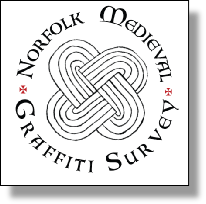








A Merchant’s Mark was a distinctive symbol used by a merchant for a variety of purposes. It could be used to mark his goods and property, in signing documents and even on his personal seal. It was a symbol that would have been instantly recognisable, to both literate and illiterate, as belonging to a particular individual. It was, in effect, the ‘logo’ of the Middle Ages. However, it may well be that some of the merchant’s marks that we come across do not actually relate to a particular individual but to a religious or trade guild instead. Much as the larger Livery Companies in cities such as London had their own specialist mark, it would appear that the practice was copied by the more modest local guilds, and at least a proportion of the markings we come across may relate to these organisations, particularly when associated with a side altar or guild chapel.
Merchant’s marks can often be mistaken for mason’s marks, and are often very similar in style and composition. However, they do show a number of distinct differences. Merchant’s marks tend to be far larger than the average mason’s mark, often appear less professionally executed and are far more likely to contain curved elements.
















